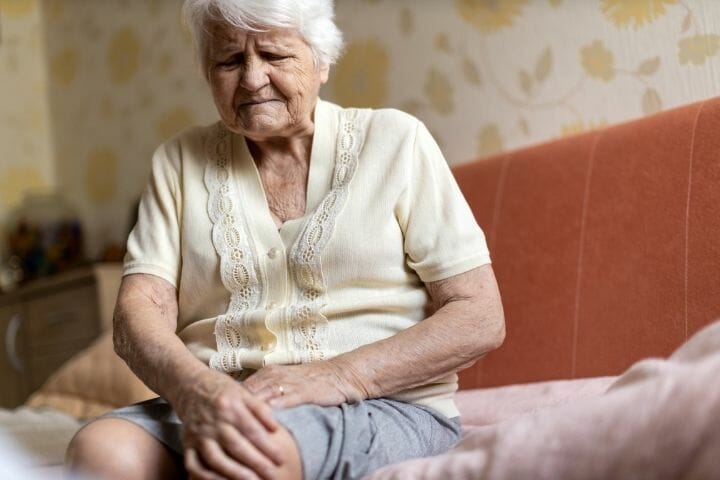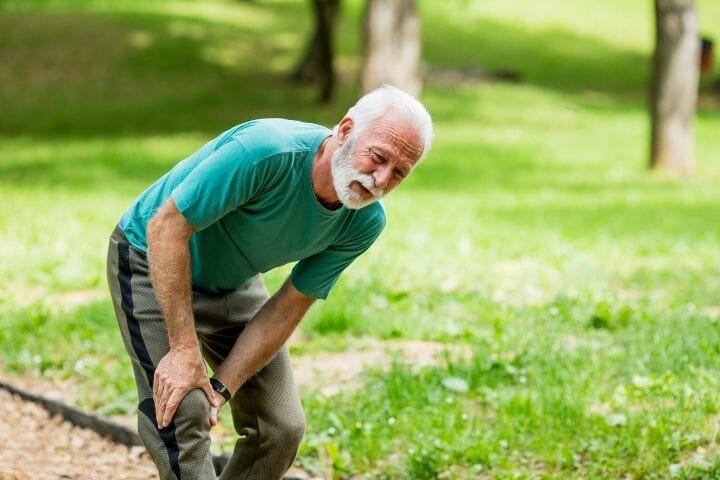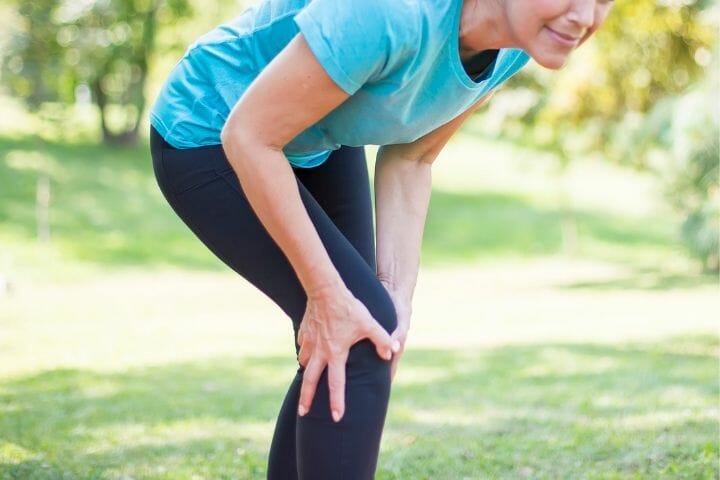Starting to feel pain in the knees? Here are some tips to prevent knee pain in old age: reasons for knee pain, which foods to eat and avoid, exercises to do, and a lot more!
Contents
Nearly 10% of people above the age of 55 suffer from knee pain, and one out of four of these people have severe pain issues. Knee pain issues are common as people grow older, but you can prevent knee pain by taking extra measures and adopting some healthy lifestyle habits.

Older people are also more likely to get knee injuries from an accident. You should become familiar with your body and learn how to prevent knee pain by correct exercise and lifestyle habits. You should also avoid nonsteroidal anti-inflammatories for your knee pain as they have side effects and can cause organ damage.
This article brings some steps for older adults to take and avoid knee pain and injuries.
What Is the Cause of Knee Pain in Old Age?
You may feel pain in your knee when you get old, but the reason for it is not fixed. There are lots of things that can cause knee pain.
Many people believe that arthritis is the cause of their knee pain. In this condition, the protective layer in your knee wears away and hurts while bending and standing. People with osteoarthritis feel a shock as they take steps. Because wearing off cartilage in your knee, it cannot absorb the shock as it used to.
The knees of a person absorb its one and half times body weight. With age, your knees’ cartilage can weaken and get damaged. After the cartilage is gone, your bones start rubbing against each other. You can also feel stiffness, swelling, and pain in your knee.
An injury can also cause knee pain. People with damaged muscle, ligament, or tendon from a sudden accident can feel knee pain when they get old. You may get knee injuries that later affect your knee include a fracture, a torn meniscus, a torn ACL, and other types of arthritis.
People with mechanical issues, including foot pain or a dislocated kneecap or hip, may get knee pain in their old age. People with the following conditions are more likely to have knee pain, including
- High BMI
- Muscle damage or change
- Knee injuries in past or present
- Family history with osteoarthritis

Tips To Prevent Knee Pain As You Age
The following tips can help the elderly to prevent knee pain and protect their knee joints as they age, including:
Eat the right amount of anti-inflammatory foods.
Some foods can cause inflammation that can damage your joints. Doctors recommend older adults follow a diet that has low inflammation value. You should avoid inflammation foods, including processed foods, as they usually contain sugar and white flour as the main ingredients which cause inflammation in the body.
You should also avoid a diet high in dairy, meat, and eggs as they also increase inflammation in the body and damage your knee joints.
Instead, you should follow an anti-inflammatory diet, including plant-based foods. You should drink a small amount of pomegranate juice every day as it contains natural anti-inflammatory acid that decreases inflammation and joint pain.
Maintain a healthy weight
Many people have problems with standing and walking due to their overweight as more weight puts more stress on the knee joints. Obese people are at higher risk of damaging the cartilage between their joints and suffer from joint pain.
Generally, your knee joints carry a pressure that is four times of your excess body weight. For example, suppose you are 20 pounds overweight, you put 80 pounds of additional pressure on your knee.
Physicians advise people to lose weight to reduce the pressure on their joints. Losing weight can also prevent developing other conditions. You can start losing weight by walking around daily.

Take supplements
Supplements are an excellent way to gain lacking nutrients. You can take a capsule of cod liver oil as it dramatically reduces the harmful enzymes that damage cartilage between the knee joints. You should protect the cartilage as it is essential for preventing joint pain.
You can also use supplements like SAM-e, which helps reduce joint inflammation and repair your damaged cartilage. You can use natural supplements, including tart cherry juice, turmeric, bromelain, and Boswellia.
A supplement, Diallyl disulfide, also helps protect the joints. It is a component of alliums like garlic and onion. Before using any supplements, you should consult them with your doctor.
Wear proper footwear
As people grow old, their shoe size changes. You should check what foot size fits you perfectly. If your feet stay uncomfortable, they may affect your joints. However, you should avoid wearing shoes as much as possible because walking barefoot helps reduce stress on the knee.
Women who wear high heels often experience knee pain when they get old. Heels significantly affect your knees as they make the quadriceps muscles strain to keep the knees in line and put more stress on the joints. You should only invest in flat shoes to protect your knee.
Use targeted exercise to build muscle.
You should use light to moderate exercise every day to protect your knee joint and build muscles. Doing a workout builds muscles around your knees that help lower the stress on your joints. You should work on the inner, outer, middle thigh, and calf muscles to support your knees.
Many local gyms provide senior exercise classes that help you build muscles in targeted areas.
You can also use swimming or water aerobics to protect your knee joint without bearing too much weight.
You can also get physical therapy to strengthen your muscles if you worry about your leg strength. Before starting any workout plan, you should check it with an expert gym trainer or physician.
You might like to read: Caregiver’s Guide To Knee Replacement
How Can You Strengthen Your Knees As You Age
Walking
You should go for a walk daily as it is one of the best exercises that you can do to secure overall health and wellness. Physicians suggest walking as a strengthening exercise for your knees; it is also an effective cardiovascular exercise. It helps you maintain mobility and proper weight and keeps you active.
Wall sits
You should do wall sits as it strengthens glutes, quadriceps, and many other small muscles around knee joints. You can do this exercise easily; all you have to do is stand with your back up against any wall with your feet about hip-distance apart, and then sit up and down.
Leg lifts
You can easily do leg lifts; you have to lie on the floor and raise your leg alternatively while keeping others on the floor. Leg lifts help strengthen muscles surrounded by joints of knees.
Set-ups
You can keep your ligaments more flexible with the help of this safest exercise, set-ups. Your ligaments may become stiffer as you grow old; keep them flexible. You can do set-ups on stairs and make a platform to do this exercise.
Knee-to-thigh stretch
This exercise keeps all the muscles of the leg flexible. You should stretch regularly to protect your knee joints.

What Foods Make Your Knees Stronger?
Avoid inflammation as much as possible and try this food to make your knees stronger, including:
- Fruit
- Seeds and nuts
- Cruciferous veggies
- Coldwater fish
- Olive oil
- Beans and lectins
- Whole grains
- Dark chocolate
- Root veggies and garlic
Wrap Up
If you still feel pain in your knee and get severe after applying these strategies to your daily life, you should see a physician. If you can’t put weight or bend on your knee, you should make an appointment with your physician as real knee pain doesn’t subside quickly.

We hope you have got some answers on how to keep your knees healthy and strong as you age. Follow the advice, exercise, and diets given here and make sure that you are not dependent on anyone in your old age.
If you love the content, do share it with others on your social media and other platforms so that others can also benefit from the knowledge.
